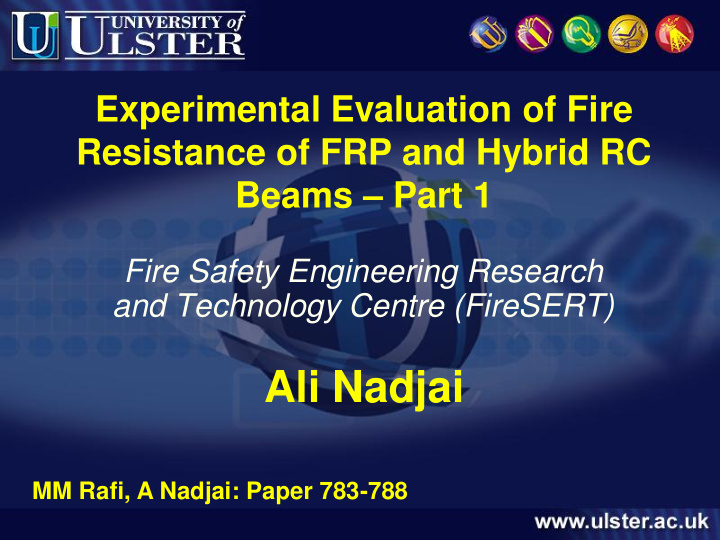



Experimental Evaluation of Fire Resistance of FRP and Hybrid RC Beams – Part 1 Fire Safety Engineering Research and Technology Centre (FireSERT) Ali Nadjai MM Rafi, A Nadjai: Paper 783-788
INTRODUCTION Fire performance of FRP RC structures unknown Improved understanding in fire needed to: ensure adequate levels of safety provide clear design guidance produce cost-effective design solutions Research focussed on GFRP bars Tests on CFRP bars reinforced beams at elevated temperatures described
TOPICS COVERED Introduction Experimental Programme Instrumentation Test Procedure Test Results Conclusions
INTRODUCTION Reinforcing Steel Advantages Disadvantages Strength Oxidation Insufficient Cover Compatibility Poor Design Poor Workmanship Marine Environment Poor Mix Deicing Salts Aggressive Environment Contaminated aggregates Cont.
INTRODUCTION FRP bars an alternate material Fibres may compose of Aramid AFRP Carbon CFRP Glass GFRP Satisfactory performance at ambient temperature Application limited to bridges Cont.
Impact of fire damage on the Economy of the Country WINDSOR TOWER THE DURATION OF FIRE WAS: 26 HOURS Madrid, the 14th of February of 2005
Fire of Disaster 200 200 150 150 100 100 50 50 WOUNDED WOUNDED DEAD DEAD 7
Fire and Natural Disasters Annual Costs
Minimum Fire Resistance for Members (Deemed to Satisfy rules
EXPERIMENTAL PROGRAMME One steel and two CFRP reinforced beams Tension Reinforcement Two 10mm steel bars OR Two 9.5mm CFRP bars Two 8mm steel bars on top 6mm rings at 100mm spacing Beam’s notation B = Beam E = Elevated temperature S = Steel, C = CFRP Cont. For example BEC1
EXPERIMENTAL PROGRAMME Simply supported beams 4 point load 400 mm 675 mm 675 mm Total span = 2000 mm 1750 mm Effective span = 1750 mm Shear span = 675 mm Heated length = 1550 mm X-section = 120 x 200 mm
FireSERT - Europe’s most up to date Fire Research Facility Furnace for Single Sub-assembling Burning structures Item (SBI) 20 Mw Calorimeter 26/10/2010 - Presentation Title
Fire Test Facilities TGA/DTA/DSC TGA FTIR: Infra red Analysis for Gases Micro balance for Quantification of toxic gases
Fire Test Facilities UFA: Universal Flammability Apparatus Standard Cone
INSTRUMENTATION LVDTs used to measure deflection and end slip Thermocouples used to record temperature Testing in floor furnace
TEST PROCEDURE Load of 40% P u Application 30 min prior to heating 20 15 Load (kN) 10 5 0 0 20 40 60 80 100 120 Cont. Time (min)
TEST PROCEDURE Beam protected on top by adjacent slabs during fire Concrete in compression unaffected Cont.
TEST PROCEDURE Heating on three sides Unheated length of 225 mm 1550 mm 225 mm 225 mm Identification and marking of cracks Cont.
TEST PROCEDURE Furnace as per ISO 834 heating curve Standard and furnace temperatures compared 1400 1400 1200 1200 Temperature ( o C) Temperature ( o C) 1000 1000 ISO-834 ISO-834 800 800 Furnace- Furnace- - BESS20-1 600 600 400 400 200 200 0 0 0 0 50 50 100 100 150 150 200 200 250 250 Time (min) Time (min)
TEST RESULTS Thermocouples fixed at several locations A TC5 A TC8 TC6 TC7 100 TC4 TC5 10 31 TC2 TC3 TC1 31 60 120 120 120 120 Cont. BESS20-1 BEHD20-2 BECS20-1 BEHD20-1
TEST RESULTS Temperature distribution at a pair TC9 TC4 500 500 Temperature ( o C) Temperature ( o C) 400 400 300 300 TC4 TC9 200 200 100 100 0 0 0 0 10 10 20 20 30 30 40 40 50 50 60 60 70 70 Time (min) Time (min) Cont.
TEST RESULTS Temperature distribution at another pair TC6 TC6 TC10 180 180 Temperature ( o C) Temperature ( o C) 150 150 120 120 TC10 TC6 90 90 60 60 30 30 0 0 0 0 10 10 20 20 30 30 40 40 50 50 60 60 70 70 Time (min) Time (min) Cont.
TEST RESULTS Temperature distribution on rebar BESS20-1 B BESS20-1 B 500 500 Temperature ( o C) Temperature ( o C) 400 400 300 300 200 200 TC5 100 100 0 0 0 0 10 10 20 20 30 30 40 40 50 50 60 60 Cont. Time (min) Time (min)
TEST RESULTS Temperature distribution at mid-span section 1000 1000 TC1 TC8 Temperature ( o C) 800 TC2 TC3 TC6 TC7 600 TC4 TC4 400 TC5 TC5 TC2 TC3 TC6 TC1 200 TC7 0 TC8 0 15 30 45 60 75 90 Time (min) Cont.
TEST RESULTS Beam BECS20-1 before and after the test Before Heating After Heating Cont.
TEST RESULTS Comparison of BECS20-1 and BESS20-1 after failure BECS20-1 BESS20-1 Cont. CFRP bar after fire
TEST RESULTS Time-deflection history BESS20-1 Beam B Beam B BECS20-1 100 100 Deflection (mm) Deflection (mm) 80 80 60 60 40 40 20 20 0 0 0 0 20 20 40 40 60 60 80 80 100 100 Cont. Time (min) Time (min)
TEST RESULTS Time-deflection history Beam B Beam B BESS20-1 BEHD20-1 BECS20-1 100 80 Deflection (mm) 60 40 20 0 0 20 40 60 80 100 120 Cont. Time (min)
TEST RESULTS Time-deflection history Beam B Beam B BESS20-1 BEHD20-1 BECS20-1 BEHD20-2 100 80 Deflection (mm) 60 40 20 0 0 20 40 60 80 100 120 Cont. Time (min)
TEST RESULTS Fire Rating BESS20-1 – 80 min BECS20-1 – 63 min BEHD20-1 – 108 min BEHD20-2 – 87 min Cont.
TEST RESULTS Polymer softens at glass transition temperature T g 100 Deflection (mm) 80 T g of the resin as 96 o C 60 40 Heat distortion temperature 104 o C 20 0 Loss of bond strength at around 200 o C 0 20 40 60 80 100 Time (min)
CONCLUSIONS No change in temperature along the length Similar temperature for steel and CFRP bars More stiff FRP RC beam than steel RC beam Similar fire resistance of BEC and BES1 beams Hybrid beams more strong and ductile compared to FRP RC beam
THANK YOU FOR YOUR ATTENTION !
More recommend